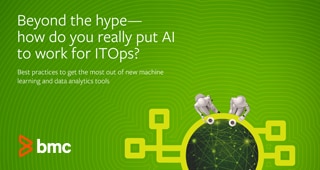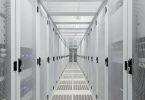In this Run and Reinvent podcast, I chat with Amaya Suarez, VP of IT at First Data, about how to create a roadmap for IT transformation. First Data is one of the largest payment processors in the world serving small merchants to large banks. Below is a condensed transcript of our conversation.
Allison Cramer: You’ve recently gone through some sort of operational transformation. Tell us about the process and how you developed a vision of where you wanted to go?
Amaya Suarez: The whole transformation started with actually defining what is that vision for us. The vision revolves around automation, getting away from manual work as well as self-service, transparency of data and so on. We laid the foundation for looking at the entire ecosystem of tools and automation that we use. One of the things that was pretty apparent is that across the globe, when we had many different monitoring solutions because the company had grown organically, where it grew through acquisitions. So, we needed to take a look at what capabilities do we need for each part of the ecosystem of tools? What are the capabilities that we need for server monitoring, not only to monitor servers that are sitting in Argentina with many, many different OS types or anywhere on the globe, as well as EC2 instances that we have? How do we monitor all these different things? And so, we went through the entire stack of tools and then determined: What is the future tool set that we need that we could standardize on that will be able to help us progress through the future?
Allison: You’ve got the mainframe, server, and the cloud. Was part of the issue you were looking at trying, trying to figure out how do I get visibility and consistency across the entire state? Or was it more: We look to have more silos of tools, depending upon infrastructure situation? How are you dealing with that challenge?
Amaya: To a certain extent. I would love it for Splunk to be able to handle logging and log analytics for every piece of infrastructure that we have in an ideal world. Now, there could be part of our infrastructure applications that we can’t log with Splunk. Or maybe we’re going to do less than real time logs. We would have to look it like, “Okay, well, if we actually really want to get mainframe data directly into Splunk, then how are we going to do that?” And that was the case with the ITSM solution. I could choose to have an ITSM solution that can handle everything except for some segment of our infrastructure. But in an ideal world, I would like to have one ITSM solution and one CMDB that covers the entire footprint. And not only the entire footprint today, but if we’re now going to start investing in Kubernetes or Docker or you name it, what that future technology will be, like serverless, then the tools that we have need to be extensible to those new scenarios also.
One of the things that I started right away was a quarterly roadmap release that we would send out to everybody in the infrastructure and application teams. It basically says, “Here’s all the things that we need to do research and analysis on, here is where we’re doing proof of concepts, and here’s the tools that we’ve selected or the new automation platforms.” It constantly needs to be evolving and keeping up. And sometimes you may select a tool set and it’s your standard tool set. We rolled it out across the globe, but you get a new use case in and that tool set is not ready for it. And that’s going to happen. You just have to be open to taking a focus on the use cases and what you need as opposed to being locked into this sort of like, “I have to stay on this tool. I love this tool, and it’s the best thing in the world.” Or this technology. It’s constant evolution, and it just has to be constantly fed with continual learning and research.
Allison: How has your communication of that roadmap going out been received in your organization? And do you feel like that had maybe any positive cultural impact or anything like that?
Amaya: It’s been good. Let’s say the application development teams that are here at First Data want to use some kind of an orchestration to do CI/CD to deploy their code. Well, what’s happened over the years is different development teams put up their own instance of Jenkins or RunDeck or whatever, you name it. But it was really more of a starvation that created that. So, having that roadmap go out that says, “Hey, we’re now researching, you know, what we should use for CI/CD.” It’s very positive, and people want to participate and test things out and see how it’s going to work.
Allison: How do you feel automation and some of the automation capabilities have played into your transformation?
Amaya: Automation is really interesting because there’s so many different forms of automation now. I’m really excited about some of the things that were starting to do there. One of the problems that I experience, though, is that there’s a lot of fear of automation. What we’re trying to do is introduce people to different forms of automation and then start building out those use cases. And people need to feel comfortable that, hey, this automation is going to be able to accomplish what needs to be done. It’s really getting people’s heads wrapped around intelligence, automation, how these things could help them do their jobs and solve problems for them so that they’re not stuck in the trenches doing things manually.
Allison: How do bots fit into your future?
Amaya: We have a huge call center presence where we provide call center services to a lot of banks, card issuers, and merchants. So, within that context, the company has started implementing interactive chatbots that can work with customers and call center people. Internally within First Data, within my team, we started a robotic process automation effort. So those are little software bots that can perform the actions that somebody might do in the call center or in our global command center where we’re operating on incidents or changes and things like that. People are starting to understand, “Hey, I could have these tasks that I do day in, day out that are really routine and I could just get myself away from doing that so I can focus on the real engineering problems or business problems that I’m trying to deal with.”
Allison: What do you think is next for your team and your journey towards transformation?
Amaya: Ultimately, one of the main goals is really self-healing infrastructure and trying to work on where the areas are that we could really carve out and move to the cloud. One of the things that I’ve been talking about recently is just if you take all your development environments that are sitting on on-prem, assuming that it’s all like Windows and Linux and whatever else, if you move it to the cloud, then you can put things on snooze schedules where you shut things, you shut things down on the weekends or when people aren’t actually doing development. It saves you money over having to, like, have that infrastructure sitting there available, waiting for people to, you know, do their coding.
Allison: Is there any other advice she would have for folks who are considering or going through their own transformation?
Amaya: I hear a lot of people talking about how they had to bring in all new people, to do this transformation and then people who have experience with these new technologies. And really, I think that it is good to always bring in some new people, but I’m a bigger fan of inspiring the people that you have already in your organization to learn new things and find out about these new technologies. I can’t even tell you how happy I have some people on my team who now totally embrace AWS and cognitive and all these different things. Initially, there’s a bit of resistance. But once they grasp how much impact that these technologies can have, they really just dive right in and love to learn new things.
Get practical guidance for AIOps
These postings are my own and do not necessarily represent BMC's position, strategies, or opinion.
See an error or have a suggestion? Please let us know by emailing blogs@bmc.com.







